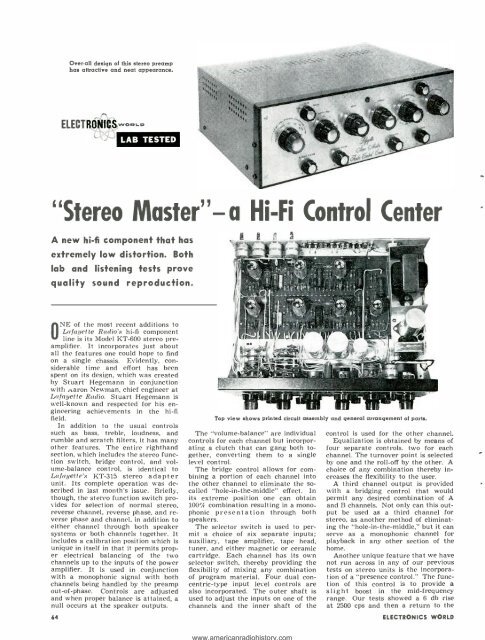Electronics-World-1959-05
Create successful ePaper yourself
Turn your PDF publications into a flip-book with our unique Google optimized e-Paper software.
Over -all design of this stereo preamp<br />
has attractive and neat appearance.<br />
ELECTRONICS--<br />
LAB TESTED<br />
"Stereo Master"- a Hi -fi Control Center<br />
A new hi -fi component that has<br />
extremely low distortion. Both<br />
lab and listening tests prove<br />
quality sound reproduction.<br />
ONE of the most recent additions to<br />
Lafayette Radio's hi -fi component<br />
line is its Model KT -600 stereo preamplifier.<br />
It incorporates just about<br />
all the features one could hope to find<br />
on a single chassis. Evidently, considerable<br />
time and effort has been<br />
spent on its design, which was created<br />
by Stuart Hegemann in conjunction<br />
with Aaron Newman, chief engineer at<br />
Lafayette Radio. Stuart Hegemann is<br />
well -known and respected for his engineering<br />
achievements in the hi -fi<br />
field.<br />
In addition to the usual controls<br />
such as bass, treble, loudness, and<br />
rumble and scratch filters, it has many<br />
other features. The entire righthand<br />
section, which includes the stereo function<br />
switch, bridge control, and volume-<br />
balance control, is identical to<br />
Lafayette :s KT -315 stereo adapter<br />
unit. Its complete operation was described<br />
in last month's issue. Briefly,<br />
though, the stereo function switch provides<br />
for selection of normal stereo,<br />
reverse channel, reverse phase, and reverse<br />
phase and channel, in addition to<br />
either channel through both speaker<br />
systems or both channels together. It<br />
includes a calibration position which is<br />
unique in itself in that it permits proper<br />
electrical balancing of the two<br />
channels up to the inputs of the power<br />
amplifier. It is used in conjunction<br />
with a monophonic signal with both<br />
channels being handled by the preamp<br />
out -of- phase. Controls are adjusted<br />
and when proper balance is attained, a<br />
null occurs at the speaker outputs.<br />
64<br />
Top view shows printed circuit assembly and general arrangement of parts.<br />
The "volume- balance" are individual<br />
controls for each channel but incorporating<br />
a clutch that can gang both together,<br />
converting them to a single<br />
level control.<br />
The bridge control allows for combining<br />
a portion of each channel into<br />
the other channel to eliminate the socalled<br />
"hole-in- the -middle" effect. In<br />
its extreme position one can obtain<br />
100e /r combination resulting in a mono-<br />
phonic presentation through both<br />
speakers.<br />
The selector switch is used to permit<br />
a choice of six separate inputs;<br />
auxiliary, tape amplifier, tape head,<br />
tuner, and either magnetic or ceramic<br />
cartridge. Each channel has its own<br />
selector switch, thereby providing the<br />
flexibility of mixing any combination<br />
of program material. Four dual concentric<br />
-type input level controls are<br />
also incorporated. The outer shaft is<br />
used to adjust the inputs on one of the<br />
channels and the inner shaft of the<br />
control is used for the other channel.<br />
Equalization is obtained by means of<br />
four separate controls. two for each<br />
channel. The turnover point is selected<br />
by one and the roll -off by the other. A<br />
choice of any combination thereby increases<br />
the flexibility to the user.<br />
A third channel output is provided<br />
with a bridging control that would<br />
permit any desired combination of A<br />
and B channels. Not only can this output<br />
be used as a third channel for<br />
stereo, as another method of eliminating<br />
the "hole -in- the -middle," but it can<br />
serve as a monophonic channel for<br />
playback in any other section of the<br />
home.<br />
Another unique feature that we have<br />
not run across in any of our previous<br />
tests on stereo units is the incorporation<br />
of a "presence control." The function<br />
of this control is to provide a<br />
slight boost in the mid -frequency<br />
range. Our tests showed a 6 db rise<br />
at 2500 cps and then a return to the<br />
ELECTRONICS WORLD



